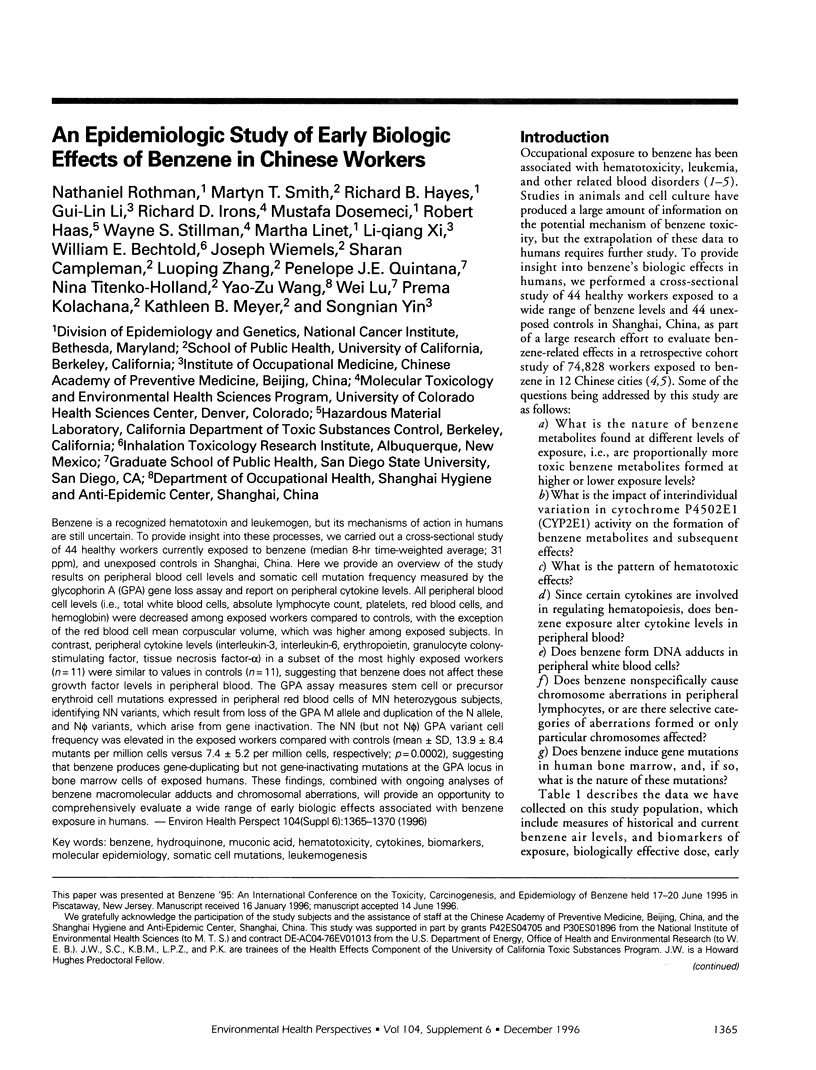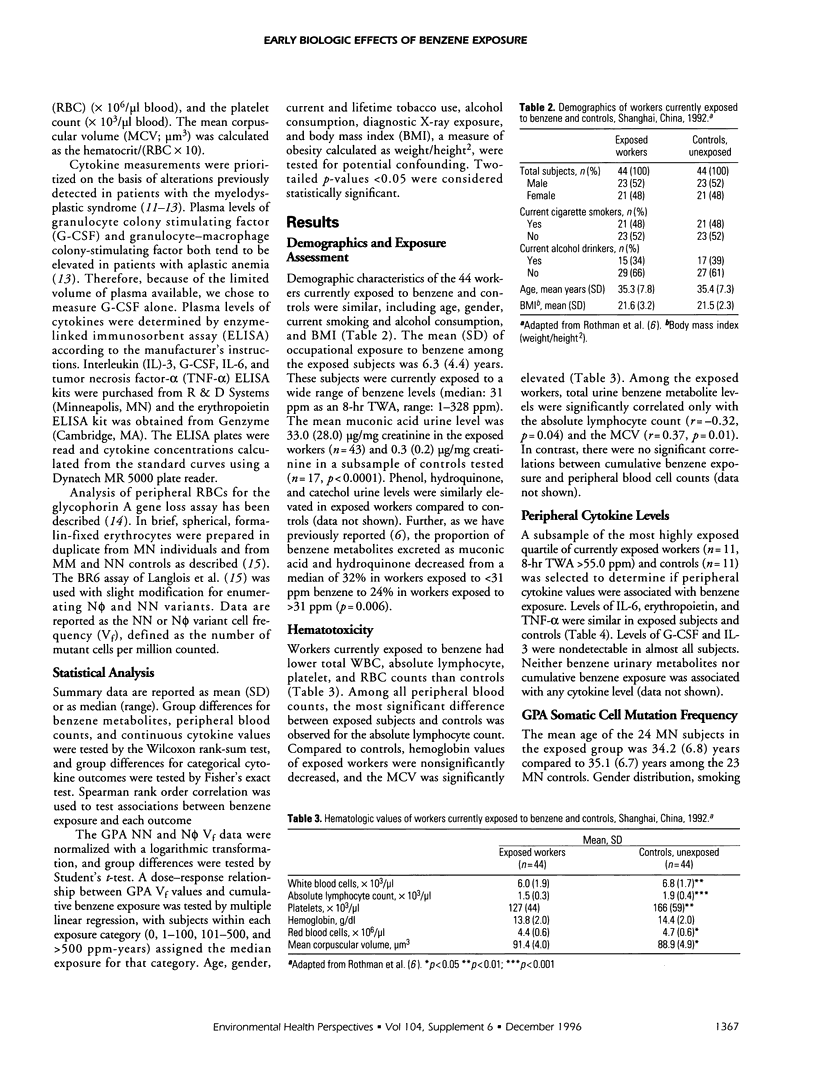Abstract
Benzene is a recognized hematotoxin and leukemogen, but its mechanisms of action in humans are still uncertain. To provide insight into these processes, we carried out a cross-sectional study of 44 healthy workers currently exposed to benzene (median 8-hr time-weighted average; 31 ppm), and unexposed controls in Shanghai, China. Here we provide an overview of the study results on peripheral blood cells levels and somatic cell mutation frequency measured by the glycophorin A (GPA) gene loss assay and report on peripheral cytokine levels. All peripheral blood cells levels (i.e., total white blood cells, absolute lymphocyte count, platelets, red blood cells, and hemoglobin) were decreased among exposed workers compared to controls, with the exception of the red blood cell mean corpuscular volume, which was higher among exposed subjects. In contrast, peripheral cytokine levels (interleukin-3, interleukin-6, erythropoietin, granulocyte colony-stimulating factor, tissue necrosis factor-alpha) in a subset of the most highly exposed workers (n = 11) were similar to values in controls (n = 11), suggesting that benzene does not affect these growth factor levels in peripheral blood. The GPA assay measures stem cell or precursor erythroid cell mutations expressed in peripheral red blood cells of MN heterozygous subjects, identifying NN variants, which result from loss of the GPA M allele and duplication of the N allele, and N phi variants, which arise from gene inactivation. The NN (but not N phi) GPA variant cell frequency was elevated in the exposed workers compared with controls (mean +/- SD, 13.9 +/- 8.4 mutants per million cells versus 7.4 +/- 5.2 per million cells, (respectively; p = 0.0002), suggesting that benzene produces gene-duplicating but not gene-inactivating mutations at the GPA locus in bone marrow cells of exposed humans. These findings, combined with ongoing analyses of benzene macromolecular adducts and chromosomal aberrations, will provide an opportunity to comprehensively evaluate a wide range of early biologic effects associated with benzene exposure in humans.
Full text
PDF





Selected References
These references are in PubMed. This may not be the complete list of references from this article.
- Aksoy M., Erdem S. Followup study on the mortality and the development of leukemia in 44 pancytopenic patients with chronic exposure to benzene. Blood. 1978 Aug;52(2):285–292. [PubMed] [Google Scholar]
- Baarson K. A., Snyder C. A., Albert R. E. Repeated exposure of C57Bl mice to inhaled benzene at 10 ppm markedly depressed erythropoietic colony formation. Toxicol Lett. 1984 Mar;20(3):337–342. doi: 10.1016/0378-4274(84)90169-3. [DOI] [PubMed] [Google Scholar]
- Bechtold W. E., Lucier G., Birnbaum L. S., Yin S. N., Li G. L., Henderson R. F. Muconic acid determinations in urine as a biological exposure index for workers occupationally exposed to benzene. Am Ind Hyg Assoc J. 1991 Nov;52(11):473–478. doi: 10.1080/15298669191365072. [DOI] [PubMed] [Google Scholar]
- Boehm T., Rabbitts T. H. A chromosomal basis of lymphoid malignancy in man. Eur J Biochem. 1989 Oct 20;185(1):1–17. doi: 10.1111/j.1432-1033.1989.tb15074.x. [DOI] [PubMed] [Google Scholar]
- Chang J. M., Metcalf D., Lang R. A., Gonda T. J., Johnson G. R. Nonneoplastic hematopoietic myeloproliferative syndrome induced by dysregulated multi-CSF (IL-3) expression. Blood. 1989 May 1;73(6):1487–1497. [PubMed] [Google Scholar]
- Cronkite E. P., Drew R. T., Inoue T., Hirabayashi Y., Bullis J. E. Hematotoxicity and carcinogenicity of inhaled benzene. Environ Health Perspect. 1989 Jul;82:97–108. doi: 10.1289/ehp.898297. [DOI] [PMC free article] [PubMed] [Google Scholar]
- Dempster A. M., Snyder C. A. Short term benzene exposure provides a growth advantage for granulopoietic progenitor cells over erythroid progenitor cells. Arch Toxicol. 1990;64(7):539–544. doi: 10.1007/BF01971832. [DOI] [PubMed] [Google Scholar]
- Dosemeci M., Li G. L., Hayes R. B., Yin S. N., Linet M., Chow W. H., Wang Y. Z., Jiang Z. L., Dai T. R., Zhang W. U. Cohort study among workers exposed to benzene in China: II. Exposure assessment. Am J Ind Med. 1994 Sep;26(3):401–411. doi: 10.1002/ajim.4700260313. [DOI] [PubMed] [Google Scholar]
- Eastmond D. A., Smith M. T., Irons R. D. An interaction of benzene metabolites reproduces the myelotoxicity observed with benzene exposure. Toxicol Appl Pharmacol. 1987 Oct;91(1):85–95. doi: 10.1016/0041-008x(87)90196-7. [DOI] [PubMed] [Google Scholar]
- Farris G. M., Everitt J. I., Irons R. D., Popp J. A. Carcinogenicity of inhaled benzene in CBA mice. Fundam Appl Toxicol. 1993 May;20(4):503–507. doi: 10.1006/faat.1993.1061. [DOI] [PubMed] [Google Scholar]
- Glatt H., Padykula R., Berchtold G. A., Ludewig G., Platt K. L., Klein J., Oesch F. Multiple activation pathways of benzene leading to products with varying genotoxic characteristics. Environ Health Perspect. 1989 Jul;82:81–89. doi: 10.1289/ehp.898281. [DOI] [PMC free article] [PubMed] [Google Scholar]
- Goldstein B. D. Benzene toxicity. Occup Med. 1988 Jul-Sep;3(3):541–554. [PubMed] [Google Scholar]
- Goldstein B. D. Benzene toxicity: a critical evaluation: hematotoxicity in humans. J Toxicol Environ Health Suppl. 1977;2:69–105. [PubMed] [Google Scholar]
- Gu Y., Cimino G., Alder H., Nakamura T., Prasad R., Canaani O., Moir D. T., Jones C., Nowell P. C., Croce C. M. The (4;11)(q21;q23) chromosome translocations in acute leukemias involve the VDJ recombinase. Proc Natl Acad Sci U S A. 1992 Nov 1;89(21):10464–10468. doi: 10.1073/pnas.89.21.10464. [DOI] [PMC free article] [PubMed] [Google Scholar]
- Hayes R. B., Yin S. N., Dosemeci M., Li G. L., Wacholder S., Chow W. H., Rothman N., Wang Y. Z., Dai T. R., Chao X. J. Mortality among benzene-exposed workers in China. Environ Health Perspect. 1996 Dec;104 (Suppl 6):1349–1352. doi: 10.1289/ehp.961041349. [DOI] [PMC free article] [PubMed] [Google Scholar]
- Herold M., Schmalzl F., Zwierzina H. Increased serum interleukin 6 levels in patients with myelodysplastic syndromes. Leuk Res. 1992 Jun-Jul;16(6-7):585–588. doi: 10.1016/0145-2126(92)90006-s. [DOI] [PubMed] [Google Scholar]
- Irons R. D., Neptun D. A. Effects of the principal hydroxy-metabolites of benzene on microtubule polymerization. Arch Toxicol. 1980 Oct;45(4):297–305. doi: 10.1007/BF00293810. [DOI] [PubMed] [Google Scholar]
- Irons R. D., Stillman W. S. Cell proliferation and differentiation in chemical leukemogenesis. Stem Cells. 1993 May;11(3):235–242. doi: 10.1002/stem.5530110311. [DOI] [PubMed] [Google Scholar]
- Irons R. D., Stillman W. S., Colagiovanni D. B., Henry V. A. Synergistic action of the benzene metabolite hydroquinone on myelopoietic stimulating activity of granulocyte/macrophage colony-stimulating factor in vitro. Proc Natl Acad Sci U S A. 1992 May 1;89(9):3691–3695. doi: 10.1073/pnas.89.9.3691. [DOI] [PMC free article] [PubMed] [Google Scholar]
- Irons R. D., Stillman W. S. Impact of benzene metabolites on differentiation of bone marrow progenitor cells. Environ Health Perspect. 1996 Dec;104 (Suppl 6):1247–1250. doi: 10.1289/ehp.961041247. [DOI] [PMC free article] [PubMed] [Google Scholar]
- Lang R. A., Metcalf D., Gough N. M., Dunn A. R., Gonda T. J. Expression of a hemopoietic growth factor cDNA in a factor-dependent cell line results in autonomous growth and tumorigenicity. Cell. 1985 Dec;43(2 Pt 1):531–542. doi: 10.1016/0092-8674(85)90182-5. [DOI] [PubMed] [Google Scholar]
- Langlois R. G., Nisbet B. A., Bigbee W. L., Ridinger D. N., Jensen R. H. An improved flow cytometric assay for somatic mutations at the glycophorin A locus in humans. Cytometry. 1990;11(4):513–521. doi: 10.1002/cyto.990110410. [DOI] [PubMed] [Google Scholar]
- Omori F., Okamura S., Shimoda K., Otsuka T., Harada M., Niho Y. Levels of human serum granulocyte colony-stimulating factor and granulocyte-macrophage colony-stimulating factor under pathological conditions. Biotherapy. 1992;4(2):147–153. doi: 10.1007/BF02171759. [DOI] [PubMed] [Google Scholar]
- Peter R., Böcker R., Beaune P. H., Iwasaki M., Guengerich F. P., Yang C. S. Hydroxylation of chlorzoxazone as a specific probe for human liver cytochrome P-450IIE1. Chem Res Toxicol. 1990 Nov-Dec;3(6):566–573. doi: 10.1021/tx00018a012. [DOI] [PubMed] [Google Scholar]
- Rothman N., Haas R., Hayes R. B., Li G. L., Wiemels J., Campleman S., Quintana P. J., Xi L. J., Dosemeci M., Titenko-Holland N. Benzene induces gene-duplicating but not gene-inactivating mutations at the glycophorin A locus in exposed humans. Proc Natl Acad Sci U S A. 1995 Apr 25;92(9):4069–4073. doi: 10.1073/pnas.92.9.4069. [DOI] [PMC free article] [PubMed] [Google Scholar]
- Rothman N., Li G. L., Dosemeci M., Bechtold W. E., Marti G. E., Wang Y. Z., Linet M., Xi L. Q., Lu W., Smith M. T. Hematotoxicity among Chinese workers heavily exposed to benzene. Am J Ind Med. 1996 Mar;29(3):236–246. doi: 10.1002/(SICI)1097-0274(199603)29:3<236::AID-AJIM3>3.0.CO;2-O. [DOI] [PubMed] [Google Scholar]
- Rushmore T., Snyder R., Kalf G. Covalent binding of benzene and its metabolites to DNA in rabbit bone marrow mitochondria in vitro. Chem Biol Interact. 1984 Apr;49(1-2):133–154. doi: 10.1016/0009-2797(84)90057-7. [DOI] [PubMed] [Google Scholar]
- Sabourin P. J., Bechtold W. E., Griffith W. C., Birnbaum L. S., Lucier G., Henderson R. F. Effect of exposure concentration, exposure rate, and route of administration on metabolism of benzene by F344 rats and B6C3F1 mice. Toxicol Appl Pharmacol. 1989 Jul;99(3):421–444. doi: 10.1016/0041-008x(89)90151-8. [DOI] [PubMed] [Google Scholar]
- Schwartz C. S., Snyder R., Kalf G. F. The inhibition of mitochondrial DNA replication in vitro by the metabolites of benzene, hydroquinone and p-benzoquinone. Chem Biol Interact. 1985 May;53(3):327–350. doi: 10.1016/s0009-2797(85)80108-3. [DOI] [PubMed] [Google Scholar]
- Snyder R., Dimitriadis E., Guy R., Hu P., Cooper K., Bauer H., Witz G., Goldstein B. D. Studies on the mechanism of benzene toxicity. Environ Health Perspect. 1989 Jul;82:31–35. doi: 10.1289/ehp.898231. [DOI] [PMC free article] [PubMed] [Google Scholar]
- Stocking C., Löliger C., Kawai M., Suciu S., Gough N., Ostertag W. Identification of genes involved in growth autonomy of hematopoietic cells by analysis of factor-independent mutants. Cell. 1988 Jun 17;53(6):869–879. doi: 10.1016/s0092-8674(88)90329-7. [DOI] [PubMed] [Google Scholar]
- Turner D. R., Grist S. A., Janatipour M., Morley A. A. Mutations in human lymphocytes commonly involve gene duplication and resemble those seen in cancer cels. Proc Natl Acad Sci U S A. 1988 May;85(9):3189–3192. doi: 10.1073/pnas.85.9.3189. [DOI] [PMC free article] [PubMed] [Google Scholar]
- Verhoef G. E., De Schouwer P., Ceuppens J. L., Van Damme J., Goossens W., Boogaerts M. A. Measurement of serum cytokine levels in patients with myelodysplastic syndromes. Leukemia. 1992 Dec;6(12):1268–1272. [PubMed] [Google Scholar]
- Yin S. N., Hayes R. B., Linet M. S., Li G. L., Dosemeci M., Travis L. B., Li C. Y., Zhang Z. N., Li D. G., Chow W. H. A cohort study of cancer among benzene-exposed workers in China: overall results. Am J Ind Med. 1996 Mar;29(3):227–235. doi: 10.1002/(SICI)1097-0274(199603)29:3<227::AID-AJIM2>3.0.CO;2-N. [DOI] [PubMed] [Google Scholar]
- Yin S. N., Li G. L., Tain F. D., Fu Z. I., Jin C., Chen Y. J., Luo S. J., Ye P. Z., Zhang J. Z., Wang G. C. Leukaemia in benzene workers: a retrospective cohort study. Br J Ind Med. 1987 Feb;44(2):124–128. doi: 10.1136/oem.44.2.124. [DOI] [PMC free article] [PubMed] [Google Scholar]
- Zhang L., Rothman N., Wang Y., Hayes R. B., Bechtold W., Venkatesh P., Yin S., Wang Y., Dosemeci M., Li G. Interphase cytogenetics of workers exposed to benzene. Environ Health Perspect. 1996 Dec;104 (Suppl 6):1325–1329. doi: 10.1289/ehp.961041325. [DOI] [PMC free article] [PubMed] [Google Scholar]
- de Vries J. D., Salphati L., Horie S., Becker C. E., Hoener B. A. Variability in the disposition of chlorzoxazone. Biopharm Drug Dispos. 1994 Oct;15(7):587–597. doi: 10.1002/bdd.2510150706. [DOI] [PubMed] [Google Scholar]


